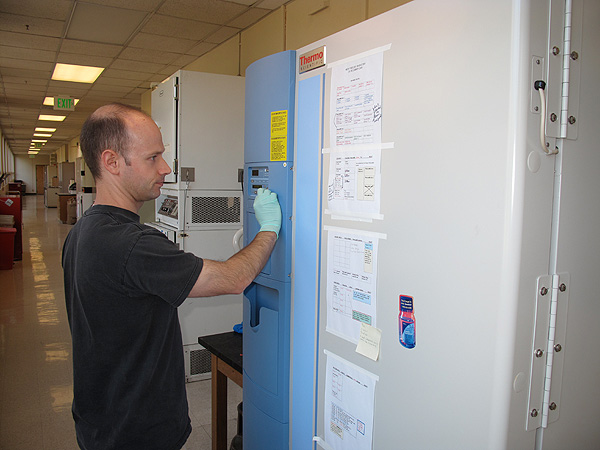Freezer Retirement Program: Out with the cold, in with the new
Stanford's Department of Sustainability and Energy Management is urging researchers to go green and get rid of their old ultra-low-temperature freezers. Labs get cash to buy new energy-efficient freezers or use new technology to store biological samples at room temperature.
BY GWYNETH DICKEY
Labs at Stanford have the chance to go a little greener this year, thanks to the Ultra-Low-Temperature Freezer Retirement Program. The initiative, led by the Department of Sustainability and Energy Management, aims to decrease the number of laboratory freezers on campus. For researchers who can't live without a freezer, the program also offers incentives to upgrade to a more energy-efficient model.
Laboratory freezers store tissue, blood and DNA samples at temperatures as low as minus 80 degrees Celsius, depending on what material is being stored and for how long. They can protect frozen samples from damage for decades. Right now, Stanford has more than 2,000 of these freezers and the number is growing.
This translates to huge energy costs for the university. The freezers consume an estimated 40 billion BTUs of energy, generate 3,600 tons of carbon dioxide and cost $5.6 million to operate each year.
"If we could get rid of 25 percent of freezers, it would be fantastic from cost, energy, space and security standpoints," said Susan Kulakowski-Vargas, campus demand-side energy manager and coordinator for the program.
Cash incentives available
Until the end of August, the program will provide cash incentives - typically between $5,100 and $7,600 - for researchers to retire a freezer, replace an inefficient freezer with a more efficient one, convert some of their samples to a form that doesn't require freezer storage or make a combination of these changes.
The Department of Sustainability and Energy Management has a similar initiative with the School of Medicine, called the "Cash for Clunkers" program. Together, the initiatives aim to retire 20 freezers before the programs end on Aug. 31. If that goal is met, the utilities savings should pay for the program in five years, Kulakowski-Vargas said.
The program needs to receive applications no later than Aug. 15, in order to have time to process them before the programs end, she said, adding, "Sooner is better."
One form of non-freezer storage for DNA and RNA samples uses a new technology that mimics anhydrobiosis, or life without water, evolved by some fungal spores, yeast cells, invertebrates such as brine shrimp and certain plant seeds to survive desert conditions.
As these organisms dry out, they replace water with sugar to preserve their DNA, protein and membranes for decades to centuries. Similarly, this particular dry-storage technology replaces water with a synthetic compound that protects DNA and RNA for long-term dry preservation. The compound replaces water in the sample and also forms a protective glasslike material around the DNA or RNA structure. All it takes is a little bit of water to reconstitute the sample.
The technology involves coating small plastic plates or tubes with the compound; the researchers then mix in DNA or RNA samples and air-dry them. The samples are stored indefinitely at room temperature in small portable cabinets (roughly the size of a microwave oven) that are humidity-controlled with silica gel.
Right now, only DNA and RNA molecules are hardy enough to survive the new room temperature storage, but similar technology for more delicate blood and proteins is being developed.
Dry, room temperature storage allows more samples to be packed into a smaller space and requires vastly fewer energy resources to maintain. The storage cabinets require no energy to run.
Since the storage cabinets don't need electricity, samples are not vulnerable to power outages, unlike those stored in freezers, meaning researchers have one less thing to worry about after a natural disaster like an earthquake. Kulakowski-Vargas hopes this advantage will provide an incentive for researchers to switch.
Need to overcome inertia
"The hard thing is to overcome inertia of how [the researchers] have always done things, to convince them that the dry, room temperature storage is just as good," Kulakowski-Vargas said. "But we think there are a lot of advantages, which is why we're providing incentives."
A six-month pilot project last year involved a dozen Stanford researchers. Darren Morrow, a research technician in Virginia Walbot's maize genetics lab in the Department of Biology, managed her lab's freezer replacement project.
"Over the years you start to accumulate a lot of samples," Morrow said. "We work with corn and have quite a bit of tissue that we collect over the summer months each year."
He and the other lab members cleared out a lot of old samples, throwing away the ones they didn't need and putting samples needed for five years or less into storage at minus 20 C, rather than the minus 80 C required for longer term preservation. As a result, they retired two freezers and purchased a new energy-efficient model. Morrow also converted a good portion of the lab's DNA and RNA samples to dry, room temperature storage.
Morrow says he has complete confidence in the dry storage and would encourage other university researchers to try it. He tested and compared the quality of RNA samples stored at minus 80 C and room temperature after two months of storage.
"Everything was exactly the same," Morrow said. "I think it's definitely a worthwhile technology. The best way to convince yourself is to test it out."
There will probably be a comparable program again next year, Kulakowski-Vargas said, but the details haven't been worked out yet.
Researchers interested in the rebate program should contact Shalini Singh in Utilities at (650) 721-1267.
Gwyneth Dickey is an intern with the Stanford News Service.


